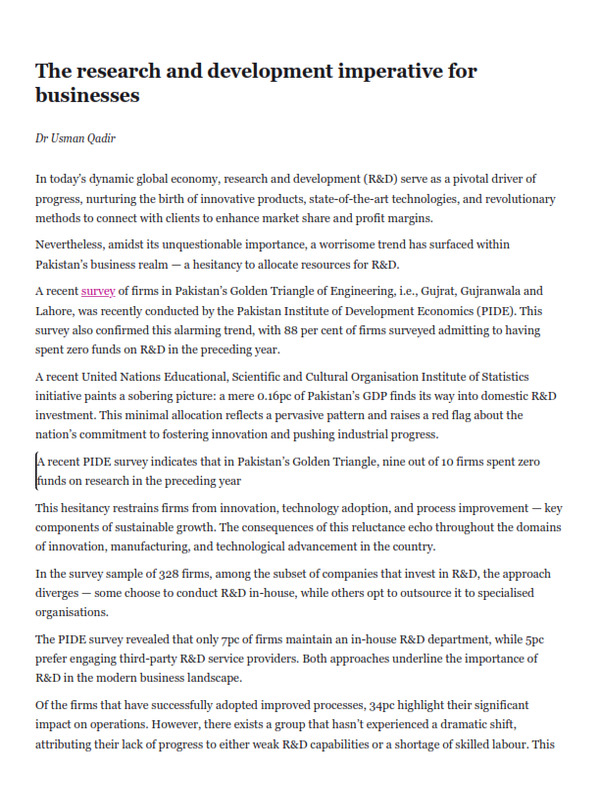The research and development imperative for businesses
In today’s dynamic global economy, research and development (R&D) serve as a pivotal driver of progress, nurturing the birth of innovative products, state-of-the-art technologies, and revolutionary methods to connect with clients to enhance market share and profit margins.
Nevertheless, amidst its unquestionable importance, a worrisome trend has surfaced within Pakistan’s business realm — a hesitancy to allocate resources for R&D.
A recent survey of firms in Pakistan’s Golden Triangle of Engineering, i.e., Gujrat, Gujranwala and Lahore, was recently conducted by the Pakistan Institute of Development Economics (PIDE). This survey also confirmed this alarming trend, with 88 per cent of firms surveyed admitting to having spent zero funds on R&D in the preceding year.
A recent United Nations Educational, Scientific and Cultural Organisation Institute of Statistics initiative paints a sobering picture: a mere 0.16pc of Pakistan’s GDP finds its way into domestic R&D investment. This minimal allocation reflects a pervasive pattern and raises a red flag about the nation’s commitment to fostering innovation and pushing industrial progress.
A recent PIDE survey indicates that in Pakistan’s Golden Triangle, nine out of 10 firms spent zero funds on research in the preceding year
This hesitancy restrains firms from innovation, technology adoption, and process improvement — key components of sustainable growth. The consequences of this reluctance echo throughout the domains of innovation, manufacturing, and technological advancement in the country.
In the survey sample of 328 firms, among the subset of companies that invest in R&D, the approach diverges — some choose to conduct R&D in-house, while others opt to outsource it to specialised organisations.
The PIDE survey revealed that only 7pc of firms maintain an in-house R&D department, while 5pc prefer engaging third-party R&D service providers. Both approaches underline the importance of R&D in the modern business landscape.
Of the firms that have successfully adopted improved processes, 34pc highlight their significant impact on operations. However, there exists a group that hasn’t experienced a dramatic shift, attributing their lack of progress to either weak R&D capabilities or a shortage of skilled labour. This finding underscores the critical interplay between R&D, skilled human resources, and operational efficacy.
Engineering firms reported facing a myriad of issues in securing funds for investment. The general mindset of entrepreneurs is one of “little is enough”, with 63pc of firms feeling it in their best interest to remain small and not expand. The drive and ambition to go big, take risks and fail appear to be lacking.
Firms have limited collateral to offer lenders, reducing their appeal to banks and commercial lenders and constraining their ability to invest in R&D. The PIDE survey results highlight 95pc of firms reporting they have limited access to finance.
Companies in Pakistan appear stuck in quicksand — facing difficulties in introducing new products to the market, staying attuned to customer needs, embracing advanced manufacturing techniques, and optimising their processes.
This stagnation impedes the acquisition of new technologies and advanced methodologies, a truth exemplified by the staggering statistic that 66pc of firms have failed to adopt any new technology or improved processes in manufacturing over the past five years. As a result, these firms are unable to generate greater sales, hence profits and unable to grow.
Considering this pressing issue, firms must contemplate the path forward. The need to invest in R&D and secure skilled labour has never been more crucial. As global markets evolve and technology advances at an unprecedented pace, firms cannot afford to lag behind. The nexus between R&D investment, innovation, and operational efficacy needs to be prioritised in strategic planning.
The government can play a key role in encouraging firms to invest in R&D. One way to do this is to provide tax breaks for firms that invest in R&D. The government can also encourage funding for R&D projects through the Export Development Fund.
Additionally, the government can create a more favourable environment for innovation by strengthening intellectual property rights and realigning skill development programmes in the country to meet the demand for skilled labour by the private sector.
The country needs to reevaluate its business strategies. Together, we must all come together to cultivate a culture of innovation, inspire investments in R&D, and develop a skilled labour force. Only through these concerted efforts can we start on a path toward sustainable growth, technological advancement, and global recognition for Pakistan’s industries.
Pakistan’s firms are at a crossroads — a pivotal juncture where choices today will shape their tomorrow. Embracing R&D isn’t merely an option, it’s an imperative. It’s the key to navigating a rapidly changing business landscape, to unlock untapped potential, and to secure a competitive edge. The journey might be challenging, but the rewards are worth the investment — both for individual firms and the nation’s economic prosperity as a whole.
The writer is a senior research economist at PIDE.
X (formerly Twitter): UsmanQEconomist
Published in Dawn, The Business and Finance Weekly, October 9th, 2023




